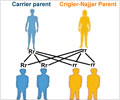A genetic mutation in the FluMist intranasal flu vaccine has the potential to be altered to enhance the vaccine's protective effect.

‘Only one component of FluMist - the one targeting the Type A H1N1 virus - has been failing in the U.S. recently and it's not clear exactly why it has failed.’





This flu season marks the second that the panel that advises the Centers for Disease Control and Prevention (CDC) on vaccines has recommended that FluMist not be used in the U.S. The Advisory Committee on Immunization Practice found that the vaccine had grown less effective in recent years, possibly due to shifts in circulating flu strains, and researchers have been searching for ways to restore its effectiveness. In the new study, the Bloomberg School researchers discovered a previously overlooked mutation, present within two of the viral strains used in the vaccine, that reduces virus production. When the researchers reversed the mutation in one of the viruses, the virus became more active, making copies of itself - which is known as replicating - more quickly in cultured human nasal cells and inducing a stronger production of immune proteins.
The findings appears in the journal Vaccine.
"Only one component of FluMist - the one targeting the Type A H1N1 virus - has been failing in the U.S. recently," says Andrew S. Pekosz, PhD, professor in the Bloomberg School's Department of Molecular Microbiology and Immunology. "It's not clear exactly why it has failed but this mutation we identified could be used to make that component of the vaccine a little stronger, thereby improving vaccine efficacy. We now see the possibility of altering this mutation and perhaps others in the vaccine to optimize the vaccine's protective effect, perhaps for different age groups."
Three types of influenza viruses affect people, Type A, Type B and Type C, and flu vaccines include a mix of virus strains tailored to anticipate the upcoming flu season. The CDC estimates that over the past seven years, flu viruses have caused 9.2 million to 60.8 million illnesses, 140,000 to 710,000 hospitalizations, and 12,000 to 56,000 deaths annually in the U.S. Across the globe, there are an estimated three to five million cases of severe flu cases and about 250,000 to 500,000 deaths.
Advertisement
Scientists in previous studies have linked the slower replication of this cold-adapted strain to changes in three virus genes. However, there have been hints in recent years, from Pekosz's work and others', that another gene encoding a viral protein called M2 may also contribute to this effect.
Advertisement
The researchers found that when they introduced this same mutation into a strain of influenza A virus that normally doesn't have it, the replication rate of the virus dropped. Alternate mutations at the same site on the M2 gene also resulted in a slowing of viral replication.
The team then did the opposite experiment, starting with a FluMist influenza A strain and reversing the M2 mutation. They found that this enhanced the replication rate of the strain in human nasal cells.
The enhanced activity of the virus also led to a jump in production, in infected cells, of the immune protein interferon lambda, indicating an increased immune response. The result showed in principle that this mutation site, and perhaps others on the virus, may be used as "dimmer switches" to adjust the vaccine's strength up or down--so that it induces a robustly protective immune response without also causing illness.
"What we're trying to do now is make a panel of these LAIV viruses with different mutations to see if we can boost the replication rates to get vaccine formulations that protect children and other age groups better than LAIV has done in the past few years," Pekosz says.
Source-Eurekalert















